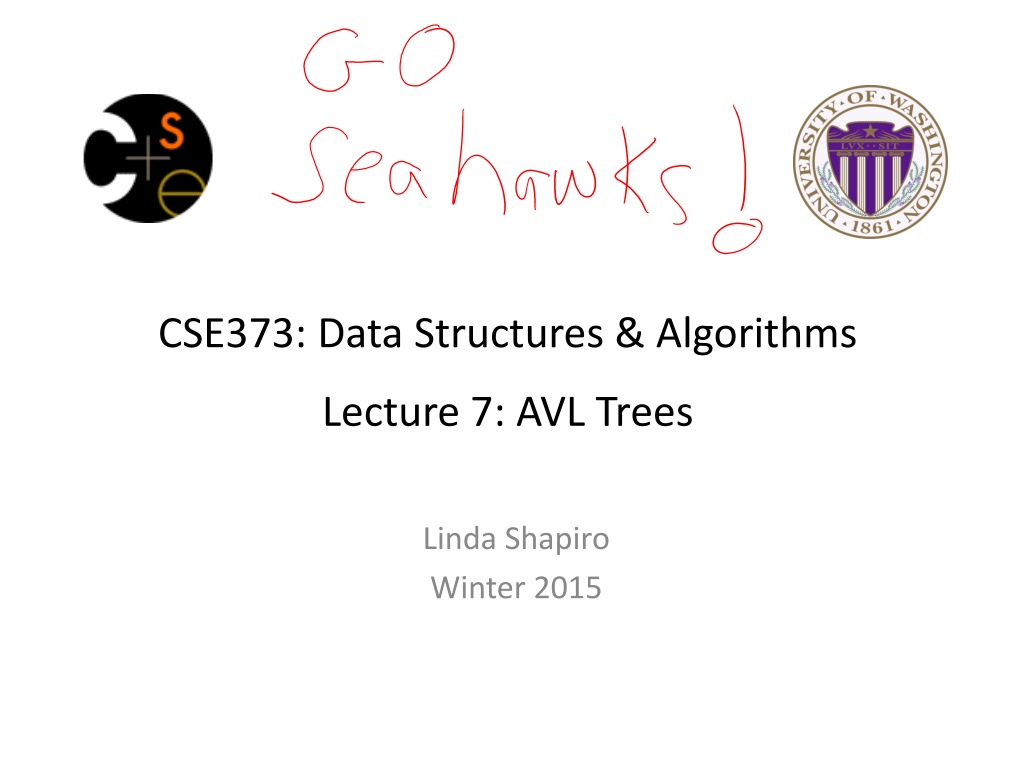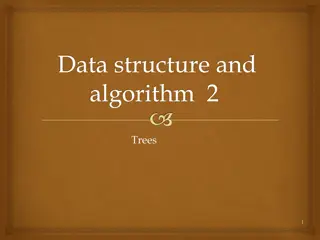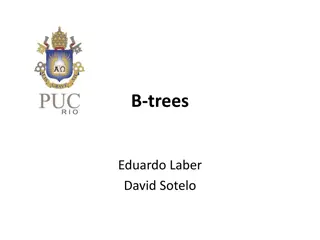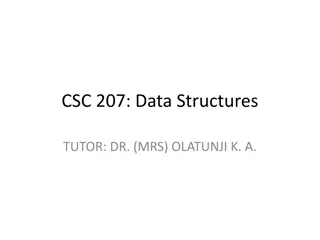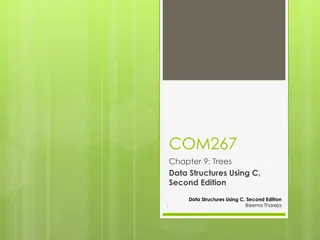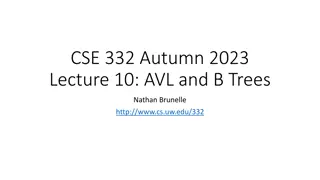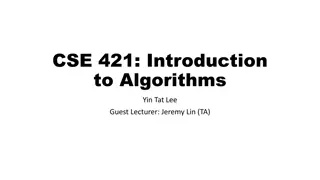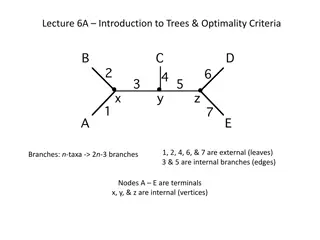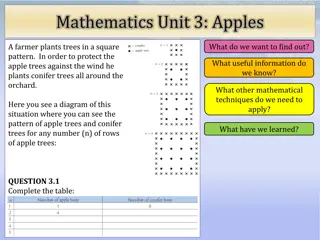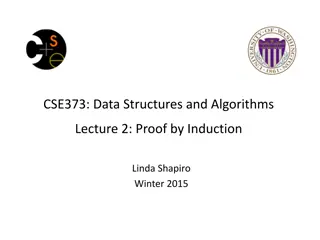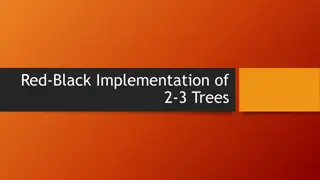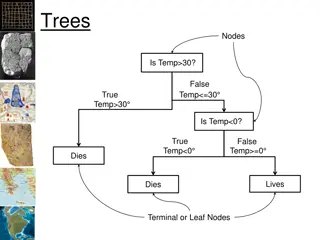AVL Trees in Data Structures
AVL trees are self-balancing binary search trees that help maintain efficiency in operations by ensuring the tree remains balanced. By enforcing a balance condition, AVL trees aim to keep the depth of the tree logarithmic, leading to O(log n) complexity for operations such as find, insert, and delete. This summary delves into the efficiency of binary search trees, the importance of balance conditions, and potential criteria for achieving balance in AVL trees.
Uploaded on Nov 25, 2024 | 0 Views
Download Presentation

Please find below an Image/Link to download the presentation.
The content on the website is provided AS IS for your information and personal use only. It may not be sold, licensed, or shared on other websites without obtaining consent from the author.If you encounter any issues during the download, it is possible that the publisher has removed the file from their server.
You are allowed to download the files provided on this website for personal or commercial use, subject to the condition that they are used lawfully. All files are the property of their respective owners.
The content on the website is provided AS IS for your information and personal use only. It may not be sold, licensed, or shared on other websites without obtaining consent from the author.
E N D
Presentation Transcript
CSE373: Data Structures & Algorithms Lecture 7: AVL Trees Linda Shapiro Winter 2015
Announcements HW2 due TODAY TA sessions this week Thursday: Binary Search Trees and AVL Trees Last lecture: Binary Search Trees Today AVL Trees Winter 2015 CSE373: Data Structures & Algorithms 2
Review: Binary Search Tree (BST) Structure property (binary tree) Each node has 2 children Result: keeps operations simple 8 Order property All keys in left subtree smaller than node s key All keys in right subtree larger than node s key Result: easy to find any given key 5 11 2 6 10 12 4 7 9 14 13 Winter 2015 CSE373: Data Structures & Algorithms 3
BST: Efficiency of Operations? Problem: operations may be inefficient if BST is unbalanced. Find, insert, delete O(n) in the worst case BuildTree O(n2) in the worst case Winter 2015 CSE373: Data Structures & Algorithms 4
How can we make a BST efficient? Observation BST: the shallower the better! Solution: Require and maintain a Balance Condition that 1. Ensures depth is alwaysO(logn) strong enough! 2. Is efficient to maintain not too strong! When we build the tree, make sure it s balanced. BUT Balancing a tree only at build time is insufficient because sequences of operations can eventually transform our carefully balanced tree into the dreaded list So, we also need to also keep the tree balanced as we perform operations. Winter 2015 CSE373: Data Structures & Algorithms 5
Potential Balance Conditions 1. Left and right subtrees of the root have equal number of nodes Too weak! Height mismatch example: 2. Left and right subtrees of the root have equal height Too weak! Double chain example: Winter 2015 CSE373: Data Structures & Algorithms 6
Potential Balance Conditions 3. Left and right subtrees of every node have equal number of nodes Too strong! Only perfect trees (2n 1 nodes) 4. Left and right subtrees of every node have equal height Too strong! Only perfect trees (2n 1 nodes) Winter 2015 CSE373: Data Structures & Algorithms 7
The AVL Balance Condition Left and right subtrees of every node have heights differing by at most 1 Definition: balance(node) = height(node.left) height(node.right) AVL property: for every node x, 1 balance(x) 1 Ensures small depth This is because an AVL tree of height h must have a number of nodes exponential in h Thus height must be log(number of nodes). Efficient to maintain Using single and double rotations 8 Winter 2015 CSE373: Data Structures & Algorithms
The AVL Tree Data Structure An AVL tree is a self-balancing binary search tree. Structural properties 1. Binary tree property (same as BST) 2. Order property (same as for BST) 1. Balance property: balance of every node is between -1 and 1 Result: Worst-case depth is O(log n) Named after inventors Adelson-Velskii and Landis (AVL) First invented in 1962 Winter 2015 CSE373: Data Structures & Algorithms 9
Is this an AVL tree? 3 6 1 2 4 8 0 1 11 0 1 7 0 0 12 10 Yes! Because the left and right subtrees of every node have heights differing by at most 1 Winter 2015 CSE373: Data Structures & Algorithms 10
Is this an AVL tree? 4 6 3 1 4 8 2 1 5 7 11 0 0 0 3 1 2 0 Nope! The left and right subtrees of some nodes (e.g. 1, 4, 6) have heights that differ by more than 1 Winter 2015 CSE373: Data Structures & Algorithms 11
What do AVL trees give us? If we have an AVL tree, then the number of nodes is an exponential function of the height. Thus the height is a log function of the number of nodes! And thus find is O(logn) But as we insert and delete elements, we need to: 1. Track balance 2. Detect imbalance 3. Restore balance Winter 2015 CSE373: Data Structures & Algorithms 12
An AVL Tree Node object key 10 3 value 10 height 3 2 2 children 5 20 1 1 0 0 15 30 2 9 0 0 7 17 Track height at all times! Winter 2015 CSE373: Data Structures & Algorithms 13
AVL tree operations AVL find: Same as BST find AVL insert: First BST insert, thencheck balance and potentially fix the AVL tree Four different imbalance cases AVL delete: The easy way is lazy deletion Otherwise, do the deletion and then check for several imbalance cases (we will skip this) Winter 2015 CSE373: Data Structures & Algorithms 14
Insert: detect potential imbalance 1. 2. Insert the new node as in a BST (a new leaf) For each node on the path from the root to the new leaf, the insertion may (or may not) have changed the node s height So after insertion in a subtree, detect height imbalance and perform a rotation to restore balance at that node 3. All the action is in defining the correct rotations to restore balance Fact that an implementation can ignore: There must be a deepest element that is imbalanced after the insert (all descendants still balanced) After rebalancing this deepest node, every node is balanced So at most one node needs to be rebalanced Winter 2015 CSE373: Data Structures & Algorithms 15
Case #1: Example Insert(6) Insert(3) Insert(1) 0 1 2 6 6 6 0 1 3 3 Third insertion violates balance property happens to be at the root 0 1 1 What is the only way to fix this? 3 0 0 6 1 Winter 2015 CSE373: Data Structures & Algorithms 16
Fix: Apply Single Rotation Single rotation:The basic operation we ll use to rebalance Move child of unbalanced node into parent position Parent becomes the other child (always okay in a BST!) Other subtrees move in only way BST allows (next slide) AVL Property violated at node 6 1 2 3 6 1 0 0 3 1 6 0 1 Child s new-height = old-height-before-insert Winter 2015 CSE373: Data Structures & Algorithms 17
The example generalized: Left of Left Insertion into left-left grandchild causes an imbalance 1 of 4 possible imbalance causes (other 3 coming up!) Creates an imbalance in the AVL tree (specifically a is imbalanced) h+2 a h+3 a h+1 h+2 h b h b h h h+1 h Z Z X Y X Y Winter 2015 CSE373: Data Structures & Algorithms 18
Winter 2015 CSE373: Data Structures & Algorithms 19
Winter 2015 CSE373: Data Structures & Algorithms 20
The general left-left case So we rotate at a Move left child of unbalanced node into parent position Parent becomes the right child Other sub-trees move in the only way BST allows: using BST facts: X < b < Y < a < Z h+3 h+2 a b h+2 h+1 h a b h h+1 h+1 h h Z X X Y Y Z A single rotation restores balance at the node To same height as before insertion, so ancestors now balanced Winter 2015 CSE373: Data Structures & Algorithms 21
Another example: insert(16) 15 8 22 24 19 4 10 6 3 17 20 16 15 8 19 22 4 10 17 16 20 24 6 3 Winter 2015 CSE373: Data Structures & Algorithms 22
The general right-right case Mirror image to left-left case, so you rotate the other way Exact same concept, but needs different code h+3 a h+2 b h+2 h h+1 b h+1 a h X h h h+1 Z Y Z X Y Winter 2015 CSE373: Data Structures & Algorithms 23
Two cases to go Unfortunately, single rotations are not enough for insertions in the left-right subtree or the right-left subtree Simple example: insert(1), insert(6), insert(3) First wrong idea: single rotation like we did for left-left 2 1 1 Violates order property! 6 1 6 0 0 3 1 0 3 Winter 2015 CSE373: Data Structures & Algorithms 24
Two cases to go Unfortunately, single rotations are not enough for insertions in the left-right subtree or the right-left subtree Simple example: insert(1), insert(6), insert(3) Second wrong idea: single rotation on the child of the unbalanced node 2 2 1 1 Still unbalanced! 1 1 6 3 0 0 3 6 Winter 2015 CSE373: Data Structures & Algorithms 25
Sometimes two wrongs make a right First idea violated the order property Second idea didn t fix balance But if we do both single rotations, starting with the second, it works! (And not just for this example.) Double rotation: 1. Rotate problematic child and grandchild 2. Then rotate between self and new child 2 2 1 1 1 3 1 6 1 3 0 0 0 0 3 1 6 6 Winter 2015 CSE373: Data Structures & Algorithms 26
The general right-left case h+3 a h+2 h b h+1 h c X h h-1 Z V U h+2 c h+3 h+1 a h+1 b h+2 a h h c h h h+1 h h-1 b U X h-1 V X U Z h V Z Winter 2015 CSE373: Data Structures & Algorithms 27
Comments Like in the left-left and right-right cases, the height of the subtree after rebalancing is the same as before the insert So no ancestor in the tree will need rebalancing Does not have to be implemented as two rotations; can just do: h+3 h+2 a c h+2 h b h+1 h+1 h+ 1 b h a c h X h h h-1 h h-1 Z U V V X U Z Easier to remember than you may think: Move c to grandparent s position Put a, b, X, U, V, and Z in the only legal positions for a BST Winter 2015 CSE373: Data Structures & Algorithms 28
The last case: left-right Mirror image of right-left Again, no new concepts, only new code to write h+3 h+2 a c h+2 h b h+1 h+ 1 h+1 a b c h Z h h h h-1 h h-1 U V X X U Z V Winter 2015 CSE373: Data Structures & Algorithms 29
Insert, summarized Insert as in a BST Check back up path for imbalance, which will be 1 of 4 cases: Node s left-left grandchild is too tall Node s left-right grandchild is too tall Node s right-left grandchild is too tall Node s right-right grandchild is too tall Only one case occurs because tree was balanced before insert After the appropriate single or double rotation, the smallest- unbalanced subtree has the same height as before the insertion So all ancestors are now balanced Winter 2015 CSE373: Data Structures & Algorithms 30
Example 3 10 2 2 5 20 1 1 0 0 15 30 2 9 0 0 7 17 Winter 2015 CSE373: Data Structures & Algorithms 31
Insert a 6 What s the deepest node that is unbalanced? 4 What s the case? 10 3 What do we do? 2 5 20 2 1 0 0 15 30 2 9 0 1 left-left 7 17 0 6 Winter 2015 CSE373: Data Structures & Algorithms 32
Insert a 6 3 10 2 2 5 20 1 1 0 0 15 30 2 7 0 0 0 6 17 9 Winter 2015 CSE373: Data Structures & Algorithms 33
Insert a 13 3 10 2 2 5 20 1 1 0 0 15 30 2 7 0 0 0 17 6 13 9 Winter 2015 CSE373: Data Structures & Algorithms 34
Insert a 14 4 10 2 What is the deepest unbalanced node? 3 5 20 1 2 0 0 15 30 2 7 0 1 0 0 17 6 13 9 140 Winter 2015 CSE373: Data Structures & Algorithms 35
Insert a 14 4 10 2 What is the deepest unbalanced node? 3 5 20 1 2 0 0 15 30 2 7 Which of the four cases is this? 0 1 0 0 17 6 13 9 Still left-left! Single rotation 140 Winter 2015 CSE373: Data Structures & Algorithms 36
Insert a 14 3 10 2 2 5 15 1 0 1 2 7 1 20 13 0 0 0 0 30 17 0 14 6 9 Winter 2015 CSE373: Data Structures & Algorithms 37
Now efficiency Worst-case complexity of find: O(logn) Tree is balanced Worst-case complexity of insert: O(logn) Tree starts balanced A rotation is O(1) and there s an O(logn) path to root Tree ends balanced Worst-case complexity of buildTree: O(n logn) Takes some more rotation action to handle delete Winter 2015 CSE373: Data Structures & Algorithms 38
Pros and Cons of AVL Trees Arguments for AVL trees: 1. All operations logarithmic worst-case because trees are always balanced Height balancing adds no more than a constant factor to the speed of insert and delete 2. Arguments against AVL trees: 1. 2. 3. 4. More difficult to program & debug [but done once in a library!] More space for height field Asymptotically faster but rebalancing takes a little time If amortized (later) logarithmic time is enough, use splay trees (also in the text) Winter 2015 CSE373: Data Structures & Algorithms 39
